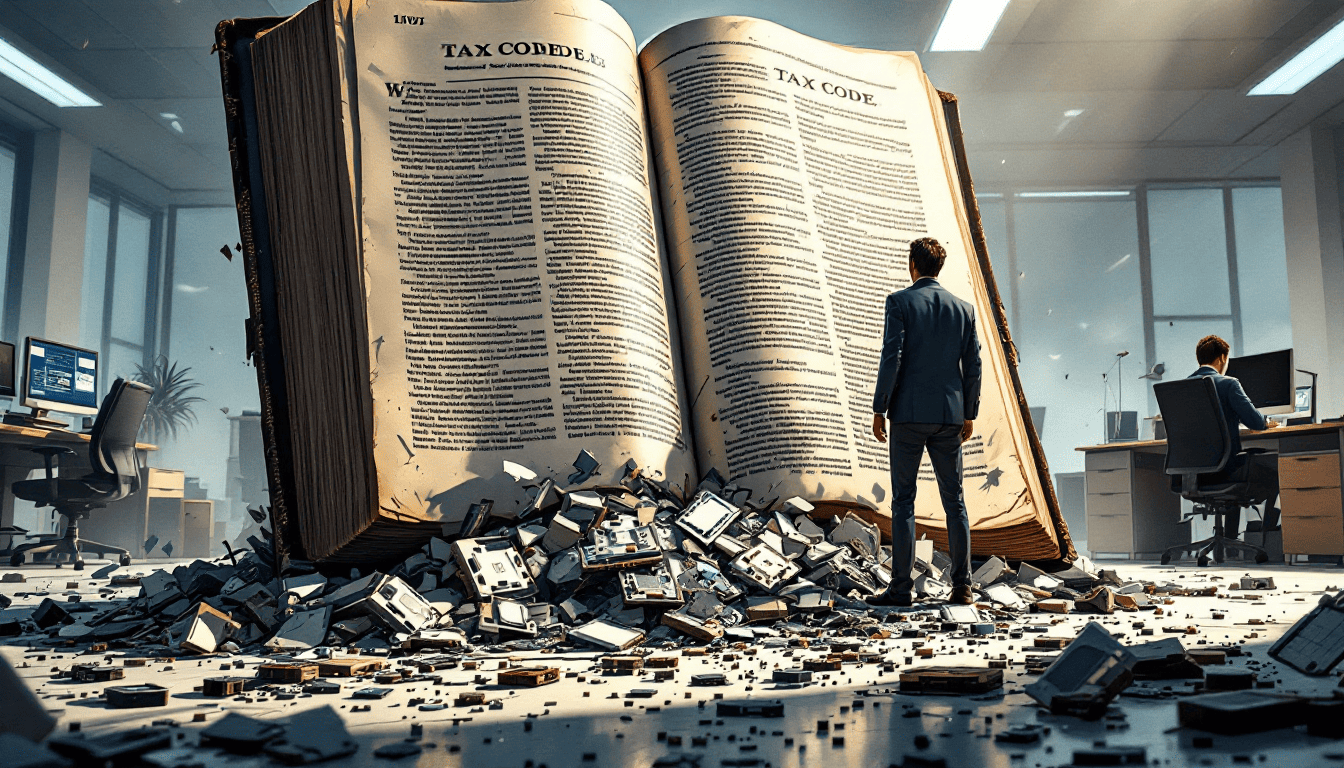IRS Section 174: The Tiny Clause Which Killed Silicon Valley
A 2017 tax change forced companies to spread R&D deductions over 5 years instead of deducting immediately. This created phantom profits, unexpected tax bills, and destroyed startup cash flow—triggering 500,000+ tech layoffs before Congress finally reversed it in 2025.

There's a peculiar silence surrounding one of the most destructive policy changes in recent American economic history. Over 500,000 tech workers lost their jobs between 2022 and 2024, yet the conversation fixated on artificial intelligence, over-hiring, and interest rates. Meanwhile, buried in a 2017 tax bill, a seven-decade-old provision was quietly gutted—and with it, the economic model that built modern Silicon Valley.
The provision in question? Section 174 of the Internal Revenue Code. What it did was simple: for nearly seventy years, it allowed companies to immediately deduct research and development expenses. Starting in tax year 2022, however, the Tax Cuts and Jobs Act required capitalising R&D costs and deducting them over five years for domestic work, fifteen years for foreign.
To the uninitiated, this sounds like tedious accountancy. To anyone who understands how innovation actually works, it was economic vandalism.
The Salary That Became an Asset
Before 2022, if you hired an engineer for £200,000, you deducted £200,000 from your taxable income that year. The logic was straightforward: you pay the salary, you get the deduction. Cash out, tax benefit in. The timing matched.
After 2022, that simple equation shattered. Now you could only deduct 10% in the first year due to the mid-year convention, then 20% annually for the next four years, with a final 10% in year six. The engineer still needs paying every fortnight. The electricity bill doesn't wait. The cloud computing costs arrive monthly. But the tax benefit? That dribbles in over five and a half years, like a mortgage payment stretched across presidential administrations.
This wasn't just an accounting change. It was a fundamental redefinition of what an engineer represents on a balance sheet. Previously, engineers were operating expenses—the cost of doing business, like rent or staplers. Now they were capital assets, like factory equipment or property. You don't expense a lathe in the year you buy it; you depreciate it slowly. Congress had decided engineering salaries should work the same way.
The absurdity becomes clear with a concrete example. Take a software company with £1 million in revenue and £1 million in engineering costs. In 2021, that company had zero taxable profit. Simple maths. In 2022, under Section 174, it suddenly had £900,000 in taxable profit—triggering a tax bill of £189,000 at the 21% corporate rate. Same business. Same cash flow. Same loss, economically speaking. But now owing nearly two hundred grand to the government despite breaking even.
For startups operating near zero, this wasn't a rounding error. It was existential. One Omaha software firm, in business since 1976, saw its taxable income triple overnight—even though it had already spent that money on salaries—and had to take out a loan for the first time in its 49-year history. Another startup that raised £1.25 million and hired five engineers suddenly faced a £150,000 tax bill it never budgeted for. These aren't hypothetical scenarios from a think tank white paper. These are real businesses, with real people, facing real consequences from a policy change most of them didn't even know was coming.
When Innovation Becomes a Liability
Every additional R&D hire now creates immediate tax liability without immediate tax relief. Companies pay salaries every two weeks—payroll doesn't pause whilst you wait for tax deductions to vest. But under Section 174, you can only deduct a sliver of those costs each year. The result? Taxable income appears on paper even when cash flow is deeply negative. You're showing a "profit" to the IRS whilst your bank account hemorrhages money.
This creates what economists politely call a "cash flow mismatch" and what founders more accurately call a nightmare. You've got real expenses going out the door today, but tax benefits that won't fully materialise until 2027. In the meantime, you're paying taxes on income that doesn't exist in any meaningful economic sense.
The rational response became obvious: freeze hiring. Reclassify developers as "maintenance" rather than "development" to dodge the rules entirely. Shift work offshore—where, paradoxically, costs must be amortised over fifteen years instead of five, making even that option barely viable and killing jobs abroad as well. Or, most simply: cut headcount.
Tech experienced a 60% surge in layoffs between 2022 and 2023, with entire R&D divisions vanishing overnight. Not because the work wasn't valuable. Not because the products weren't selling. Because the tax code made innovation financially untenable. Across the broader U.S. economy, job cuts hovered in the low single digits. But in tech? Entire floors emptied. Slack channels went quiet. Engineers who'd spent years building products were shown the door, their roles eliminated not by automation or competition, but by tax policy.
Consider the calculus for a cash-strapped startup in practical terms. You've raised £3 million in venture capital—a decent seed round. You're pre-revenue but building something genuinely novel. Your burn rate is £250,000 monthly, mostly engineering salaries. That gives you twelve months of runway, enough time to build a prototype, get initial traction, and raise a Series A.
Then the 2022 tax bill arrives. You're suddenly facing a £150,000 tax liability you never budgeted for, on phantom profits that don't exist in reality. Your twelve-month runway just became nine months. Your choices? Lay off two engineers, cutting your development speed and potentially missing your product launch window. Take out a high-interest loan at 10% or more, burning cash on debt service instead of development. Beg your investors for bridge funding, diluting yourself and signalling desperation. Or slow development to a crawl and hope you can outlast the tax burden.
None of these options leads to faster innovation. All of them increase the likelihood of failure. And that's exactly what happened, hundreds of times over, in garages and offices and co-working spaces across America.
The Product Strategy Distortion
Long-term R&D projects became financially toxic. If you're going to pay taxes on engineering costs before seeing any revenue, you're incentivised to chase short-term monetisation over breakthrough innovation. Why spend three years developing a revolutionary new architecture when the tax code punishes you for each month your engineers aren't generating immediate revenue?
The bias shifts decisively toward incremental improvements and quick wins. Add a feature to an existing product rather than reimagine the category. Optimize what you've got rather than explore what you could have. Maintenance over invention. Iteration over revolution.
This matters because the technology sector's greatest contributions have never come from safe bets. The smartphone, cloud computing, social networks, electric vehicles, mRNA vaccines—none of these emerged from companies optimising quarterly tax bills. They came from organisations willing to lose money for years whilst building something unprecedented. Section 174 made that approach vastly more expensive, tipping the scales toward conservatism and away from frontier thinking.
There's also the geographic distortion. With domestic R&D amortised over five years and foreign over fifteen, you might expect a strong incentive to keep work onshore. In practice, the effect was more complicated. Many companies simply stopped hiring engineers altogether, domestic or foreign. Others explored hybrid models, using contractors and agencies to obscure the employment relationship. Still others shifted work to foreign subsidiaries that could book the costs differently under international tax structures.
The unifying theme? Rather than encouraging domestic innovation, Section 174 created a game of tax Twister, where companies contorted themselves into increasingly baroque structures to avoid triggering the capitalisation requirements. Energy spent on tax optimization is energy not spent building products.
The Cascade Effect Across the Ecosystem
Throughout the 2010s, startups built growth strategies around engineered break-even, spending aggressively on product and engineering whilst writing it all off as R&D. The tax code rewarded long-term thinking over short-term profit. You could run at a loss indefinitely, provided you were investing in development. Many successful tech companies didn't turn a profit for years—Amazon, Spotify, Uber, Twitter. The model was deliberate: grow fast, capture market share, worry about profitability later. Section 174's original intent, dating back to 1954, was precisely this: encourage American companies to invest domestically in R&D, accepting short-term losses for long-term strategic advantage.
The 2022 change flipped that script entirely. Now the tax code punishes innovation work. It taxes you for employing engineers. It creates phantom profits that destroy runway. The playbook that built the modern tech economy suddenly stopped working.
It wasn't a coincidence that Meta announced its 'Year of Efficiency' immediately after Section 174 took effect. The timing matched perfectly: new tax rules in 2022, mass layoffs in early 2023. Meta cut nearly a quarter of its workforce. Microsoft faced nearly £5 billion in extra taxes in 2023 and trimmed 7% of headcount. Netflix confronted an additional £368 million in tax liability. Amazon, Alphabet, and Salesforce all eliminated thousands of positions. These are companies with enormous cash reserves—they absorbed the blow, albeit painfully. Smaller firms weren't so fortunate.
IntervalZero, a Massachusetts industrial systems firm with 50 engineers selling to clients like Panasonic and Samsung, raised prices and borrowed £2.5 million to cover the tax hit. European and Chinese competitors undercut them, slashing prices. Eventually, they laid off nearly 40% of their workforce. A small company in India employed 23 engineers for a U.S. firm; all were let go specifically because of Section 174's fifteen-year amortisation requirement for foreign R&D making their positions financially unsustainable.
The invisible hand of the market was now being twisted backwards by the visible hand of Congress, and the market did what markets do: it adjusted. Just not in the direction anyone intended.
Who This Actually Hurt (And It Wasn't Just Software)
Section 174 applies broadly to costs incurred in developing or improving any product, process, formula, invention or software. The definition of "research and experimentation" is expansive, covering everything from laboratory work to pilot production runs. That includes semiconductor engineering, pharmaceutical clinical trials, manufacturing process improvements, agricultural technology, materials science, and even architecture when it involves novel techniques.
Healthcare organisations developing custom patient platforms? Section 174. Biotech firms running drug trials? Section 174. Manufacturers improving production lines? Section 174. It hit everyone building new intellectual property, not just the hoodie-wearing startup founders of popular imagination.
According to Bureau of Economic Analysis data, roughly £500 billion in R&D was reported in 2019, with half coming from non-tech sectors. These industries suddenly faced the same impossible maths: pay engineers and scientists today, get tax deductions over the next five years, somehow survive the cash flow gap in between.
But the damage wasn't evenly distributed, which is what made it particularly insidious. Large corporations with diversified revenue streams weathered the storm. If you're generating £10 billion annually, an unexpected £50 million tax bill is painful but manageable. You adjust the dividend, delay a share buyback, shift some capital allocation. Life goes on.
It was the young, cash-constrained, pre-profit firms—the ones actually taking risks on frontier innovation—that faced annihilation. These companies live on runway. Venture capital provides eighteen to twenty-four months of breathing room to prove a concept, demonstrate traction, and raise the next round. When taxable income rises artificially, tax liability increases, and cash runway shortens—even if the business remains unprofitable under normal operating metrics and even if no actual cash profit exists.
Suddenly that eighteen-month runway becomes twelve months. Twelve becomes nine. The dream dies not from lack of talent, not from poor product-market fit, not from competitive pressure—but from a tax provision nobody saw coming until the bill arrived.
The Venture Capital Ripple Effect
The crisis propagated upstream to investors, fundamentally altering the risk calculus of early-stage funding.
Venture capitalists operate on a portfolio model: invest in ten companies, expect eight to fail, two to succeed massively, and the winners subsidise the losers. That model depends on giving companies enough runway to find product-market fit. If runway contracts by 30% due to unexpected tax liabilities, the failure rate climbs. More companies die before reaching the next funding milestone. Fewer reach the scale needed to generate venture-level returns.
Limited partners—the pension funds, endowments, and family offices that invest in venture funds—started asking harder questions. How much Section 174 exposure does your portfolio have? What percentage of your companies are R&D-heavy? Have you modelled the cash flow impact? Some firms began explicitly tracking Section 174 liability as a risk metric, as important as burn rate or valuation.
The downstream effect: venture funding for early-stage R&D-intensive companies declined. Why fund a biotech startup that will face crushing tax bills before generating revenue, when you could back a less innovative but more tax-efficient business model? The capital that built transformative technologies—the moonshots, the decade-long development cycles, the genuine breakthroughs—began flowing elsewhere.
This is how innovation dies: not with a bang, but with a spreadsheet showing that the tax-adjusted returns no longer justify the risk.
The Budget Gimmick Gone Wrong
How did any of this happen? The answer is equal parts cynical and banal.
The Tax Cuts and Jobs Act of 2017 slashed corporate tax rates from 35% to 21%, a massive revenue reduction. To comply with Senate budget reconciliation rules and avoid a filibuster, the bill needed to appear deficit-neutral over a ten-year window. This created a technical problem: how do you give away trillions in tax cuts whilst claiming fiscal responsibility?
The solution was creative accounting worthy of Enron. Include provisions that would increase future tax revenue, buried deep in the bill, scheduled to take effect years later. The expectation—shared by the drafters, lobbyists, and even many opponents—was that Congress would revisit these provisions before they took effect. They were placeholders, legislative theatre, a bit of budget Kabuki to make the numbers work on paper.
Section 174 was one such provision. A temporary measure, everyone agreed. We'll fix it later, they said. Don't worry about it, they promised.
Except they didn't fix it. December 2022 came and went without action. Industry groups lobbied furiously. The National Venture Capital Association, the Semiconductor Industry Association, the Biotechnology Innovation Organization—all pushed for repeal or delay. Multiple bipartisan bills were introduced. Everyone acknowledged the problem. Nobody could marshal the political will to solve it quickly enough.
And so, by sheer inertia and incompetence, what was supposed to be temporary became permanent. The consequences were entirely predictable and entirely predicted. Tax policy analysts warned of the impact. CFOs modelled the scenarios. Industry coalitions rang alarm bells. None of it mattered. The procedural machinery of Congress had other priorities, and fixing an obscure tax provision didn't make for compelling headlines.
The result was a textbook case of unintended consequences. A manoeuvre designed to make the tax bill's numbers work on paper ended up kneecapping the sectors that drive American competitiveness and economic growth. Meanwhile, China offers a 200% super deduction for R&D costs—spend £1 million on research, deduct £2 million from taxable income, creating an active subsidy for innovation. Europe maintained favourable innovation incentives. South Korea, Singapore, and Israel all structured their tax codes to encourage R&D investment.
The United States, by accident or incompetence, did the opposite. We decided to tax companies for employing engineers. We penalised domestic innovation. We made long-term thinking financially irrational. And then we wondered why the layoffs kept coming.
The Long Road to Reversal
Multiple bipartisan bills were introduced to reverse Section 174, with widespread support from industry coalitions and surprising agreement across the political spectrum. The American Innovation and R&D Competitiveness Act, introduced by Representatives Ron Estes (Republican) and John Larson (Democrat), sought to restore immediate expensing. Over 100 House members signed on. The rhetoric was supportive. Everyone agreed something had to be done.
But legislative gridlock, budget fights, and negotiation over unrelated provisions repeatedly stalled progress. The Tax Relief for American Families and Workers Act passed the House in January 2024, including a provision to defer capitalisation until 2026, but it died in the Senate. Bill after bill foundered on procedural rocks whilst real companies hemorrhaged cash and cut staff.
By the time the "One Big Beautiful Bill Act" finally suspended Section 174 in 2025, restoring immediate expensing for domestic R&D with retroactive relief for small businesses earning under £31 million annually, the damage had already been done. Half a million jobs gone. Countless startups shuttered or sold for parts. Product roadmaps abandoned. Engineering teams decimated. Years of American innovation surrendered to foreign competitors who faced no such constraints.
The fix itself was telling: it tacitly admitted the policy had been catastrophic by including retroactive provisions allowing companies to go back and amend their 2022-2024 returns for immediate refunds. In other words, "Sorry about the last three years, here's your money back." But you cannot retroactively un-lay-off an engineer. You cannot resurrect a failed startup. You cannot reclaim three lost years of American innovation. You cannot un-lose the competitive races that were forfeited whilst Congress dithered.
The engineers who were laid off found new jobs, often outside the innovation sector. The startups that died stayed dead. The products that were never built remained theoretical. And the momentum shifted—perhaps irretrievably—toward jurisdictions that didn't accidentally sabotage their own innovation ecosystems through budget gimmickry.
The Broader Lesson About Policy and Consequences
Section 174 reveals something profoundly uncomfortable about how policy actually works, and how catastrophically it can fail even when everyone agrees on the goal.
Nobody wanted to destroy American innovation. The Tax Cuts and Jobs Act's proponents genuinely believed they were improving competitiveness. The Section 174 provision was supposed to be temporary, a placeholder, a bit of procedural necessity that would be cleaned up later. Everyone had good intentions. Everyone assumed someone else would fix it. Everyone was wrong.
This is how disasters happen in complex systems: not through malice, but through drift. A provision gets tucked into a massive bill for budgetary reasons. It's assumed someone will fix it later. Then inertia, gridlock, and distraction take over. By the time the consequences become undeniable—by the time the layoffs hit, the tax bills arrive, the startups fail—the harm is irreversible.
The tax code should incentivise the behaviours society values. For seventy years, Section 174 treated R&D as something worth encouraging—an investment in the future, not a luxury to be taxed. It recognised that innovation requires long-term thinking, patient capital, and the willingness to lose money whilst building something unprecedented. The code rewarded companies for hiring engineers and scientists. It subsidised the risk-taking that generates breakthrough technologies.
When you tax innovation like you tax equipment, you get less innovation. When you penalise companies for employing engineers, you get fewer engineers. When you make long-term development projects financially irrational, you get short-term thinking. This isn't ideology; it's basic incentive design.
Silicon Valley wasn't built by accident. It emerged from a deliberate ecosystem: venture capital willing to fund long shots, universities generating technical talent, and yes, a tax code that rewarded companies for hiring engineers and building new things. Section 174, in its original form, was one pillar of that ecosystem. The 2022 change quietly dismantled it. The market did the rest.
Perhaps the next time Congress plays budget games with the tax code, they might consider asking the people who actually build things what happens when you turn salaries into capital assets, penalise domestic hiring, and tax companies for employing engineers. Perhaps they might model the real-world consequences before burying provisions in thousand-page bills. Perhaps they might fix problems before they metastasise into crises.
Or perhaps not. After all, tax policy is boring. The media coverage focuses on personalities and partisan battles, not on obscure provisions buried in reconciliation bills. And by the time anyone notices the consequences—by the time the layoffs make headlines, by the time startups start failing in bulk, by the time the damage becomes undeniable—it's already too late.
Section 174 was reversed, eventually. But the years between 2022 and 2025 are gone. The jobs are gone. The companies are gone. The innovations that might have been will never exist. And all of it—every lost job, every failed startup, every abandoned product—traces back to a single provision, buried in a tax bill, that nobody thought would actually take effect.
That's the real lesson: the tiny clauses kill you. Pay attention to the footnotes. Because by the time they make the headline, Silicon Valley is already dead.





